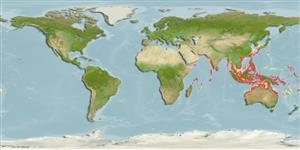Common names from other countries
Classification / Names / Names
ماع يماسا | فدارتم | Catalog of Fishes (gen., sp.) | ITIS | CoL | WoRMS
Environment: milieu / climate zone / depth range / distribution range
يسانش موب
; قمع تارييغت 0 - 40 m (Ref. 349). Tropical
Indo-West Pacific: from Madagascar and the Persian Gulf, to eastern Melanesia; north to Japan and south to Queensland and New Caledonia.
Length at first maturity / Size / Weight / نس
Maturity: Lm ? range ? - ? cm Max length : 4.5 cm SHL يسنج صاوخ نودب / رن سنج; (Ref. 349); common length : 3.0 cm SHL يسنج صاوخ نودب / رن سنج; (Ref. 349)
Used as food and for its shell (Ref. 349). From shallow subtidal levels. Members of the family Naticidae are sand or mud-dwelling, ploughing through the substrate with their expanded foot. They are active predators, preying mainly on burrowing bivalves or gastropods (Ref. 349).
Life cycle and mating behavior
غولب | لثم دیلوت | یزیر مخت | اه مخت | Fecundity | )ورال ( دازوت
Members of the order Neotaenioglossa are mostly gonochoric and broadcast spawners. Life cycle: Embryos develop into planktonic trocophore larvae and later into juvenile veligers before becoming fully grown adults.
یلصا ذخآم
عجارم | هدننك گنهامه | ناراكمه
Poutiers, J.M. 1998. (Ref. 349)
NCUI زمرق تسرهف رد تيعضو (Ref. 130435)
ستياس رظن زا تيعضو (Ref. 108899)
Not Evaluated
Not Evaluated
اه ناسنا یارب رطخ
Harmless
یناسنا هدافتسا
| FishSource |
اهرازبا
رتشيب تاعالطا
Age/Sizeدشرنزو - لوطلوط - لوطيسانش تخير)ورال ( دازوتيناوارف
يتنرتنيا عبانم
Estimates based on models
Preferred temperature
(Ref.
115969): 24.6 - 29.1, mean 28.2 (based on 1044 cells).
یريذپ بيسآ
Low vulnerability (10 of 100).
تميق هقبط
Unknown.
